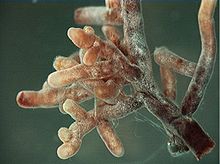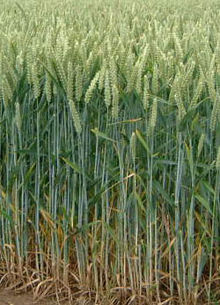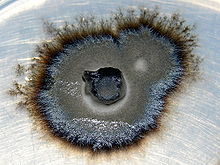- Mycorrhiza
-
 This mycorrhiza includes a fungus in the genus Amanita
This mycorrhiza includes a fungus in the genus Amanita
A mycorrhiza (Gk. μυκός, mykós, "fungus" and ριζα, riza, "roots",[1] pl mycorrhizae, mycorrhizas) is a symbiotic (generally mutualistic, but occasionally weakly pathogenic) association between a fungus and the roots of a vascular plant.[2]
In a mycorrhizal association, the fungus colonizes the host plant's roots, either intracellularly as in arbuscular mycorrhizal fungi (AMF), or extracellularly as in ectomycorrhizal fungi. They are an important component of soil life and soil chemistry.
Contents
Mutualist dynamics
Mycorrhizas form a mutualistic relationship with the roots of most plant species. While only a small proportion of all species has been examined, 95% of those plant families are predominantly mycorrhizal.[3] They are named after their presence in the plant's rhizosphere (root system).
Sugar-Water/Mineral exchange
This mutualistic association provides the fungus with relatively constant and direct access to carbohydrates, such as glucose and sucrose.[4] The carbohydrates are translocated from their source (usually leaves) to root tissue and on to the plant's fungal partners. In return, the plant gains the benefits of the mycelium's higher absorptive capacity for water and mineral nutrients due to the comparatively large surface area of mycelium: root ratio, thus improving the plant's mineral absorption capabilities.[5]
Plant roots alone may be incapable of taking up phosphate ions that are demineralized in soils with a basic pH. The mycelium of the mycorrhizal fungus can, however, access these phosphorus sources, and make them available to the plants they colonize.[6] Inga alley cropping, proposed as an alternative to slash and burn rainforest destruction,[7] relies upon Mycorrhiza within the Inga Tree root system to prevent the rain from washing phosphorus out of the soil.[8]
Suillus tomentosus, a fungus, produces specialized structures, known as tuberculate ectomycorrhizae, with its plant host lodgepole pine (Pinus contorta var. latifolia). These structures have in turn been shown to host nitrogen fixing bacteria which contribute a significant amount of nitrogen and allow the pines to colonize nutrient-poor sites.[9]
Mechanisms
 Leccinum aurantiacum, an ectomycorrhizal fungus
Leccinum aurantiacum, an ectomycorrhizal fungus
The mechanisms of increased absorption are both physical and chemical. Mycorrhizal mycelia are much smaller in diameter than the smallest root, and thus can explore a greater volume of soil, providing a larger surface area for absorption. Also, the cell membrane chemistry of fungi is different from that of plants (including organic acid excretion which aids in ion displacement[10]). Mycorrhizas are especially beneficial for the plant partner in nutrient-poor soils.[11]
Disease and drought resistance
Mycorrhizal plants are often more resistant to diseases, such as those caused by microbial soil-borne pathogens,[12][13] and are also more resistant to the effects of drought.[14][15][16]
Colonization of barren soil
Plants grown in sterile soils and growth media often perform poorly without the addition of spores or hyphae of mycorrhizal fungi to colonise the plant roots and aid in the uptake of soil mineral nutrients.[17] The absence of mycorrhizal fungi can also slow plant growth in early succession or on degraded landscapes.[18] The introduction of alien mycorrhizal plants to nutrient-deficient ecosystems puts indigenous non-mycorrhizal plants at a competitive disadvantage.[19]
Resistance to toxicity
Fungi have been found to have a protective role for plants rooted in soils with high metal concentrations, such as acidic and contaminated soils. Pine trees inoculated with Pisolithus tinctorius planted in several contaminated sites displayed high tolerance to the prevailing contaminant, survivorship and growth. One study discovered the existence of Suillus luteus strains with varying tolerance of zinc. Another study discovered that zinc-tolerant strains of Suillus bovinus conferred resistance to plants of Pinus sylvestris. This was probably due to binding of the metal to the extramatricial mycelium of the fungus, without affecting the exchange of beneficial substances.[19]
Occurrence of mycorrhizal associations
At around 400 million years old, the Rhynie chert contains the earliest fossil assemblage yielding plants preserved in sufficient detail to detect mycorrhizas - and they are indeed observed in the stems of Aglaophyton major.[20]
Mycorrhizas are present in 92% of plant families studied (80% of species),[21] with arbuscular mycorrhizas being the ancestral and predominant form,[21] and indeed the most prevalent symbiotic association found in the plant kingdom.[4] The structure of arbuscular mycorrhizas has been highly conserved since their first appearance in the fossil record,[20] with both the development of ectomycorrhizas, and the loss of mycorrhizas, evolving convergently on multiple occasions.[21]
Types of mycorrhiza
 Arbuscular mycorrhizal wheat
Arbuscular mycorrhizal wheat
Mycorrhizas are commonly divided into ectomycorrhizas and endomycorrhizas. The two types are differentiated by the fact that the hyphae of ectomycorrhizal fungi do not penetrate individual cells within the root, while the hyphae of endomycorrhizal fungi penetrate the cell wall and invaginate the cell membrane. Additionally, many plants in the order Ericales form a third type, ericoid mycorrhizas, while some members of the Ericales form arbutoid and monotropoid mycorrhizas.[22][23] All orchids are myco-heterotrophic at some stage during their lifecycle and form orchid mycorrhizas with a range of basidiomycete fungi.
Endomycorrhiza
Main article: Arbuscular mycorrhizaEndomycorrhizas are variable and have been further classified as arbuscular, ericoid, arbutoid, monotropoid, and orchid mycorrhizas.[24] Arbuscular mycorrhizas, or AM (formerly known as vesicular-arbuscular mycorrhizas, or VAM), are mycorrhizas whose hyphae enter into the plant cells, producing structures that are either balloon-like (vesicles) or dichotomously-branching invaginations (arbuscules). The fungal hyphae do not in fact penetrate the protoplast (i.e. the interior of the cell), but invaginate the cell membrane. The structure of the arbuscules greatly increases the contact surface area between the hypha and the cell cytoplasm to facilitate the transfer of nutrients between them.
Arbuscular mycorrhizas are formed only by fungi in the division Glomeromycota. Fossil evidence[20] and DNA sequence analysis[25] suggest that this mutualism appeared 400-460 million years ago, when the first plants were colonizing land. Arbuscular mycorrhizas are found in 85% of all plant families, and occur in many crop species.[21] The hyphae of arbuscular mycorrhizal fungi produce the glycoprotein glomalin, which may be one of the major stores of carbon in the soil. Arbuscular mycorrhizal fungi have (possibly) been asexual for many millions of years and, unusually, individuals can contain many genetically different nuclei (a phenomenon called heterokaryosis).[26]
Ectomycorrhiza
 Ectomycorrhizal beech
Ectomycorrhizal beech
Ectomycorrhizas, or EcM, are typically formed between the roots of around 10% of plant families, mostly woody plants including the birch, dipterocarp, eucalyptus, oak, pine, and rose[21] families and fungi belonging to the Basidiomycota, Ascomycota, and Zygomycota. Some EcM fungi, such as many Leccinum and Suillus, are symbiotic with only one particular genus of plant, while other fungi, such as the Amanita, are generalists that form mycorrhizas with many different plants.[27] An individual tree may have 15 or more different fungal EcM partners at one time.[28] Thousands of ectomycorrhizal fungal species exist, hosted in over 200 genera. A recent study has permitted to conservatively estimate global ectomycorrhizal fungal species richness around 7750 species, although, on the basis of estimates of knowns and unknowns in macromycete diversity, a final estimate of ECM species richness would likely be between 20000 and 25000.[29]
Ectomycorrhizas consist of a hyphal sheath, or mantle, covering the root tip and a hartig net of hyphae surrounding the plant cells within the root cortex. In some cases the hyphae may also penetrate the plant cells, in which case the mycorrhiza is called an ectendomycorrhiza. Outside the root, the fungal mycelium forms an extensive network within the soil and leaf litter.
Nutrients can be shown to move between different plants through the fungal network. Carbon has been shown to move from paper birch trees into Douglas-fir trees thereby promoting succession in ecosystems.[30] The ectomycorrhizal fungus Laccaria bicolor has been found to lure and kill springtails to obtain nitrogen, some of which may then be transferred to the mycorrhizal host plant. In a study by Klironomos and Hart, Eastern White Pine inoculated with L. bicolor was able to derive up to 25% of its nitrogen from springtails.[31][32]
The first genomic sequence for a representative of symbiotic fungi, the ectomycorrhizal basidiomycete Laccaria bicolor, has been published.[33] An expansion of several multigene families occurred in this fungus, suggesting that adaptation to symbiosis proceeded by gene duplication. Within lineage-specific genes those coding for symbiosis-regulated secreted proteins showed an up-regulated expression in ectomycorrhizal root tips suggesting a role in the partner communication. Laccaria bicolor is lacking enzymes involved in the degradation of plant cell wall components (cellulose, hemicellulose, pectins and pectates), preventing the symbiont from degrading host cells during the root colonisation. By contrast, Laccaria bicolor possesses expanded multigene families associated with hydrolysis of bacterial and microfauna polysaccharides and proteins. This genome analysis revealed the dual saprotrophic and biotrophic lifestyle of the mycorrhizal fungus that enables it to grow within both soil and living plant roots.
Ericoid mycorrhiza
Main article: Ericoid mycorrhizaEricoid mycorrhizas are the third of the three more ecologically important types, They have a simple intraradical (grow in cells) phase, consisting of dense coils of hyphae in the outermost layer of root cells. There is no periradical phase and the extraradical phase consists of sparse hyphae that don't extend very far into the surrounding soil. They might form sporocarps (probably in the form of small cups), but their reproductive biology is little understood.[22]
Ericoid mycorrhizas have also been shown to have considerable saprotrophic capabilities, which would enable plants to receive nutrients from not-yet-decomposed materials via the decomposing actions of their ericoid partners.[35]
Discovery
Associations of fungi with the roots of plants have been known since at least the mid-19th century. However early observers simply recorded the fact without investigating the relationships between the two organisms.[36] This symbiosis was studied and described by Franciszek Kamieński in 1879–1882.[37] Far more thorough research was carried out by Albert Bernhard Frank, who introduced the term mycorrhiza 1885.[38]
See also
- Glomeromycota
- Basidiomycota
- Ascomycota
- Mucigel - substance that creates symbiotic environment for fungi
- Rhizobia - bacteria which fix nitrogen in legumes
- Effect of climate change on plant biodiversity
References
- ^ Frank, A. B. (1885). "Über die auf Würzelsymbiose beruhende Ehrnährung gewisser Bäum durch unterirdische Pilze". Berichte der Deutschen Botanischen Gesellschaft 3: 128–145.
- ^ Kirk, P. M.; Cannon, P. F.; David, J. C. & Stalpers, J. (2001). Ainsworth and Bisby’s Dictionary of the Fungi (9th ed.). Wallingford, UK: CAB International.
- ^ Trappe, J. M. (1987). Phylogenetic and ecologic aspects of mycotrophy in the angiosperms from an evolutionary standpoint. Florida: CRC Press.
- ^ a b Harrison MJ (2005). "Signaling in the arbuscular mycorrhizal symbiosis". Annu Rev Microbiol. 59: 19–42. doi:10.1146/annurev.micro.58.030603.123749. PMID 16153162.
- ^ Selosse MA, Richard F, He X, Simard SW (2006). "Mycorrhizal networks: des liaisons dangereuses?". Trends Ecol Evol. 21 (11): 621–628. doi:10.1016/j.tree.2006.07.003. PMID 16843567.
- ^ Li H, Smith SE, Holloway RE, Zhu Y, Smith FA. (2006). "Arbuscular mycorrhizal fungi contribute to phosphorus uptake by wheat grown in a phosphorus-fixing soil even in the absence of positive growth responses". New Phytol. 172 (3): 536–543. doi:10.1111/j.1469-8137.2006.01846.x. PMID 17083683.
- ^ Elkan, Daniel. Slash-and-burn farming has become a major threat to the world's rainforest The Guardian 21 April 2004
- ^ rainforestsaver.org: What is Inga alley cropping?
- ^ Paul, L.R.; Chapman, B.K.; Chanway, C.P. (2007). "Nitrogen Fixation Associated with Suillus tomentosus Tuberculate Ectomycorrhizae on Pinus contorta var. latifolia". Annals of Botany 99: 1101–1109. doi:10.1093/aob/mcm061. http://aob.oxfordjournals.org/content/99/6/1101.full.
- ^ [1][dead link]
- ^ "Botany online: Interactions - Plants - Fungi - Parasitic and Symbiotic Relations - Mycorrhiza". Biologie.uni-hamburg.de. http://www.biologie.uni-hamburg.de/b-online/e33/33b.htm. Retrieved 2010-09-30.
- ^ "Abstract". SpringerLink. http://www.springerlink.com/content/qnrwj34011g842p2/. Retrieved 2010-09-30.
- ^ "Dr. Susan Kaminskyj: Endorhizal Fungi". Usask.ca. http://www.usask.ca/biology/kaminskyj/arctic.html. Retrieved 2010-09-30.
- ^ "Dr. Davies Research Page". Aggie-horticulture.tamu.edu. http://aggie-horticulture.tamu.edu/Faculty/davies/research/mycorrhizae.html. Retrieved 2010-09-30.
- ^ Lehto, Tarja (1992). "Mycorrhizas and Drought Resistance of Picea sitchensis (Bong.) Carr. I. In Conditions of Nutrient Deficiency". New Phytologist 122 (4): 661–668. JSTOR 2557434.
- ^ Nikolaou, N.; Angelopoulos, K.; Karagiannidis, N. (2003). "Effects of Drought Stress on Mycorrhizal and Non-Mycorrhizal Cabernet Sauvignon Grapevine, Grafted Onto Various Rootstocks". Experimental Agriculture 39 (3): 241–252. doi:10.1017/S001447970300125X.
- ^ Root fungi turn rock into soil Planet Earth Online 3 July 2009
- ^ Jeffries, P; Gianinazzi, S; Perotto, S; Turnau, K; Barea, J-M (2003). "The contribution of arbuscular mycorrhizal fungi in sustainable maintenance of plant health and soil fertility". Biol. Fertility Soils 37: 1–16. http://cat.inist.fr/?aModele=afficheN&cpsidt=14498927.
- ^ a b David M. Richardson (2000). Ecology and biogeography of Pinus. London: Cambridge University Press. p. 336. ISBN 0521789109.
- ^ a b c Remy W, Taylor TN, Hass H, Kerp H (1994). "4 hundred million year old vesicular-arbuscular mycorrhizae". Proc. National Academy of Sciences 91 (25): 11841–11843. Bibcode 1994PNAS...9111841R. doi:10.1073/pnas.91.25.11841. PMC 45331. PMID 11607500. http://www.pubmedcentral.nih.gov/articlerender.fcgi?tool=pmcentrez&artid=45331.
- ^ a b c d e Wang, B.; Qiu, Y.L. (2006). "Phylogenetic distribution and evolution of mycorrhizas in land plants". Mycorrhiza 16 (5): 299–363. doi:10.1007/s00572-005-0033-6. PMID 16845554. http://www.springerlink.com/index/X7151P60502078U1.pdf. Retrieved 2008-01-21.
- ^ a b Allen, Michael F. 1991. The ecology of mycorrhizae. Cambridge University Press, Cambridge.
- ^ Harley, J.L. and S.E. Smith 1983. Mycorrhizal symbiosis (1st ed.). Academic Press, London.
- ^ Peterson, R. L.; Massicotte, H. B. & Melville, L. H. (2004). Mycorrhizas: anatomy and cell biology. National Research Council Research Press. ISBN 9780660190877. http://pubs.nrc-cnrc.gc.ca/eng/books/books/9780660190877.html.
- ^ Simon L., Bousquet J., Lévesque R. C., Lalonde M. (1993). "Origin and diversification of endomycorrhizal fungi and coincidence with vascular land plants". Nature 363 (6424): 67–69. Bibcode 1993Natur.363...67S. doi:10.1038/363067a0.
- ^ Hijri, M.; Sanders, IR. (2005). "Low gene copy number shows that arbuscular mycorrhizal fungi inherit genetically different nuclei". Nature 433 (7022): 160–163. Bibcode 2005Natur.433..160H. doi:10.1038/nature03069. PMID 15650740.
- ^ den Bakker, Henk C.; Zuccarello, G. C.; Kuyper, TH. W.; Noordeloos, M. E. (2004). "Evolution and host specificity in the ectomycorrhizal genus Leccinum" (PDF). New Phytologist 163: 201–215. doi:10.1111/j.1469-8137.2004.01090.x. http://www.entoloma.nl/downloads/den%20Bakker%20et%20alNP.pdf.
- ^ Saari, S. K.; Campbell, C. D.; Russell, J.; Alexander, I. J.; Anderson, I. C. (2005). "Pine microsatellite markers allow roots and ectomycorrhizas to be linked to individual trees" (PDF). New Phytologist 165 (1): 295–304. doi:10.1111/j.1469-8137.2004.01213.x. PMID 15720641. http://www-mykopat.slu.se/Newwebsite/kurser/SUMMER05/READING/Anderson/Saari05.pdf.
- ^ Rinaldi, A.C.; Comandini, O.; Kuyper, T.W. (2008). "Ectomycorrhizal fungal diversity: separating the wheat from the chaff". Fungal Diversity 33: 1–45. http://www.fungaldiversity.org/fdp/sfdp/33-1.pdf.
- ^ Simard, Suzanne W.; Perry, David A.; Jones, Melanie D.; Myrold, David D.; Durall, Daniel M. & Molina, Randy (1997). "Net transfer of carbon between ectomycorrhizal tree species in the field". Nature 388 (6642): 579–582. doi:10.1038/41557. http://www.nature.com/nature/journal/v388/n6642/full/388579a0.html.
- ^ Fungi kill insects and feed host plants BNET.com
- ^ Klironomos, J. N.; Hart, M. M. (2001). "Animal nitrogen swap for plant carbon". Nature 410 (6829): 651–652. doi:10.1038/35070643. PMID 11287942.
- ^ Martin, F.; Aerts, A. et al. (2008). "The genome of Laccaria bicolor provides insights into mycorrhizal symbiosis". Nature 452 (7183): 88–92. Bibcode 2008Natur.452...88M. doi:10.1038/nature06556. PMID 18322534.
- ^ Midgley, DJ; Chambers, SM; Cairney, JWG (2002). "Spatial distribution of fungal endophyte genotypes in a Woollsia pungens (Ericaceae) root system". Australian Journal of Botany 50 (5): 559–565. doi:10.1071/BT02020.
- ^ Read, D. J. & Perez-Moreno, J. (2003). "Mycorrhizas and nutrient cycling in ecosystems—a journey towards relevance?". New Phytologist 157 (3): 475–492. doi:10.1046/j.1469-8137.2003.00704.x.
- ^ http://books.google.com/books?id=dMrzAAAAMAAJ&pg=PA99&dq=Mycorrhiza+Kamienski&hl=en&ei=n7lCTrW7J5PYiAKC4bmZAw&sa=X&oi=book_result&ct=result&resnum=8&ved=0CFcQ6AEwBw#v=onepage&q=Mycorrhiza%20Kamienski&f=false
- ^ Kamieński, F. (1882). "Les organes végétatifs de Monotropa hypopitys L.". Mémoires de la Société nat. des Sciences naturelles et mathém. de Cherbourg, ser. 3, tom. 24.
- ^ Frank, A.B. (1885). "Über die auf Wurzelsymbiose beruhende Ernährung gewisser Bäume durch unterirdische Pilze". Ber. Deutsch. Bot. Gesells. 3: 128–145.
External links
- Mycorrhizal Associations: The Web Resource Comprehensive illustrations and lists of mycorrhizal and nonmycorrhizal plants and fungi
- Mycorrhizas – a successful symbiosis Biosafety research into genetically modified barley
- International Mycorrhiza Society International Mycorrhiza Society
- MycorWiki a portal concerned with the biology and ecology of ectomycorrhizal fungi and other forest fungi.
Categories:- Plant roots
- Soil biology
- Symbiosis
- Oligotrophs
- Fungi
Wikimedia Foundation. 2010.

